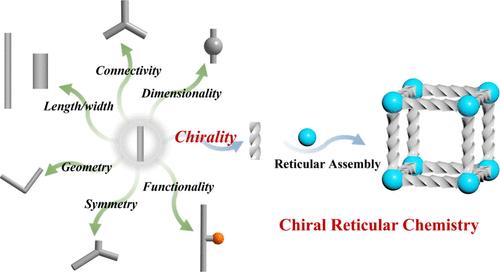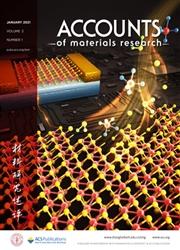Chiral Reticular Chemistry toward Functional Materials Discovery and Beyond
IF 14
Q1 CHEMISTRY, MULTIDISCIPLINARY
引用次数: 0
Abstract
Reticular chemistry, pioneered by Omar Yaghi, is concerned with linking molecular building blocks into porous crystalline 2D or 3D architectures through coordination bonds (metal–organic frameworks, MOFs) or covalent bonds (covalent organic frameworks, COFs). The successful marriage of inorganic and organic chemistry in MOFs has provided vast combinations amenable to manufacturing enormous solid materials (>100,000 in Cambridge Crystallographic Data Centre) with atomic precision. Benefiting from the immanent component and structural diversity, as well as the accessible nanometer-scale spaces within which various matter can be manipulated and controlled, the reticular framework materials have in effect not only facilitated the development of basic chemistry but also revolutionized various fields of applications including gas storage and separation, heterogeneous catalysis, heat allocation, sensors, photovoltaics, fuel cells, and biomedicine, to just name a few. One particularly intriguing subset of reticular frameworks concerns those that have chiral elements or characteristics, which represent a unique class of extended porous solids that can implement enantiomerically selective applications and beyond. However, the development of this field is still at the embryonic stage as compared with that of achiral reticular frameworks. Herein, we summarize the progress in the development of “chiral reticular chemistry” through which a serial of homochiral or racemic reticular frameworks with novel topologies and functions can be targeted. To begin, we introduce the background of reticular chemistry and the potential of using chiral building blocks to assemble reticular frameworks, particularly MOFs. In the following section, we describe the synthetic diversity and complexity using enantiopure or racemic ligands and highlight the important role of enantiopurity engineering in affecting the ultimate products. To be more specific, we present (i) isotopological synthesis in which enantiopure or racemic ligands produce frameworks with the same net topology, where the racemic ligands form either racemic frameworks or conglomerates; (ii) intrinsically chiral net-dominated synthesis in which enantiopure or racemic ligands can form different underlying topologies or undergo distinct crystallization pathways; (iii) other atypical syntheses that typically come by way of serendipity, where the assembly mechanism is highly elusive (for example, the enantiomeric ligands of opposite chirality give rise to entirely different structures). Next, we discuss the applications of these unique reticular framework materials that are otherwise unachievable by conventional achiral materials or analogues, aiming to underline the unique role of chiral building blocks in reticular chemistry. Last, we point out future research directions of “chiral reticular chemistry”. Our Account aims to highlight the importance of chirality as a decisive parameter to control the ultimate structure and function of periodic framework materials, which is largely overlooked in the history of reticular chemistry development. Through this comprehensive overview, we hope to spark future research interest in this emerging and fertile field, yielding new discoveries and innovations from the chemistry and material perspectives.

手性网状化学走向功能材料的发现及以后
Omar Yaghi开创的网状化学,关注的是通过配位键(金属有机框架,mof)或共价键(共价有机框架,COFs)将分子构建块连接成多孔的二维或三维晶体结构。mof中无机化学和有机化学的成功结合为制造具有原子精度的巨大固体材料(剑桥晶体学数据中心的100,000)提供了巨大的组合。得益于其内在的成分和结构多样性,以及各种物质可以被操纵和控制的纳米尺度空间,网状框架材料不仅促进了基础化学的发展,而且还彻底改变了各种应用领域,包括气体储存和分离,多相催化,热量分配,传感器,光伏,燃料电池和生物医学,仅举几例子。网状框架的一个特别有趣的子集涉及那些具有手性元素或特征的结构,它们代表了一类独特的扩展多孔固体,可以实现对映体选择性应用以及其他应用。然而,与非手性网状框架相比,这一领域的发展仍处于萌芽阶段。在此,我们总结了“手性网状化学”的发展进展,通过它可以针对一系列具有新颖拓扑和功能的同手性或外消旋网状框架。首先,我们介绍了网状化学的背景和使用手性构建块组装网状框架的潜力,特别是mof。在下一节中,我们描述了对映不纯或外消旋配体合成的多样性和复杂性,并强调了对映不纯工程在影响最终产物中的重要作用。更具体地说,我们提出(i)同位素合成,其中对映纯或外消旋配体产生具有相同网络拓扑结构的框架,其中外消旋配体形成外消旋框架或聚合体;(ii)固有手性网络主导合成,其中对映纯或外消旋配体可以形成不同的底层拓扑或经历不同的结晶途径;(iii)其他非典型合成,通常是通过偶然的方式进行的,其中组装机制是非常难以捉摸的(例如,手性相反的对映体配体产生完全不同的结构)。接下来,我们讨论了这些独特的网状框架材料的应用,这些材料是传统的非手性材料或类似物无法实现的,旨在强调手性构建块在网状化学中的独特作用。最后,对“手性网状化学”的未来研究方向进行了展望。我们的报告旨在强调手性作为控制周期性框架材料最终结构和功能的决定性参数的重要性,这在网状化学发展史上很大程度上被忽视了。通过这一全面的概述,我们希望激发未来对这一新兴和肥沃领域的研究兴趣,从化学和材料的角度产生新的发现和创新。
本文章由计算机程序翻译,如有差异,请以英文原文为准。
求助全文
约1分钟内获得全文
求助全文

 求助内容:
求助内容: 应助结果提醒方式:
应助结果提醒方式:


